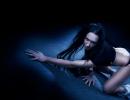Lesson No. 12-13-14
Man in the mirror of art: portrait genre
Portrait(French portrait) - an image of a specific person or group of people. The portrait genre became widespread in ancient times in sculpture, and then in painting and graphics. But external resemblance is not the only thing that an artist must convey. It is much more important when the master transfers the inner essence of a person onto the canvas and conveys the atmosphere of time. Distinguishfront door And chamber portraits. There are portraitsdoubles And group. They are intended to decorate state rooms, and to praise certain persons, and to preserve the memory of people united by professional, spiritual, and family ties. Special categoryamounts to self-portrait, on which the artist depicts himself.
Any of the portraits can be attributed either to a psychological portrait or
to a portrait-character, or to a portrait-biography.
Art helps to know a person. Not only to see his external appearance
face, but also to understand its essence, character, mood, etc. The portrait is almost
always realistic. After all, its main goal is the recognition of the depictedthere is a person on it. However, usually the artist's task is not to accuratelycopying the external features of a model, not imitation of nature, but a “pictorial re-creation” of a person’s image. It is no coincidence that the desire arisesjust recognize yourself in the portrait, and maybe even discover something new in itself.
The viewer involuntarily conveys the artist’s attitude towards the model. Important
is everything that expresses emotions, attitude towards life, towards people: facial expressions
depicted face, eye expression, lip line, head turn, posture,
gesture.
Often we interpret a work from the perspective of a person today
day, we attribute to the character traits that are completely unusual for his time, that is, we strive to understand the unknown through the known.
It is also very important to show the social position of the person being portrayed, to create a typical image of a representative of a certain era.
As a genre, portraiture appeared several thousand years ago in ancient art. Among the frescoes of the famous Knossos Palace, found by archaeologists during excavations on the island of Crete, there are a number of picturesque images of women dating back to the 16th century BC. Although researchers called these images “court ladies,” we do not know who the Cretan masters were trying to show - goddesses, priestesses or noble ladies dressed in elegant dresses.
"Parisian". Fresco from the Palace of Knossos, 16th century BC.
The most famous portrait of a young woman, called “Parisian Woman” by scientists. We see in front of us a profile (according to the traditions of the art of that time) image of a young woman, very flirtatious and not neglecting cosmetics, as evidenced by her eyes, outlined in a dark outline, and brightly painted lips.
The artists who created fresco portraits of their contemporaries did not delve into the characteristics of the models, and the external similarity in these images is very relative.
Religious ideas in Ancient Egypt associated with the cult
dead, determined the desire to convey a portrait likeness in a sculptural image of a person: the soul of the deceased had to find its container.
At the beginning of the 20th century. archaeologists have discovered a wonderful portrait of Queen Nefertiti to the whole world.

Created in XIV century BC e.,this image amazes with the smoothness of the profile lines, the grace of the flexible neck, the airy lightness and fluid transitions of the irregular but charming features of a woman’s face.
Nefertiti was not only the queen of Egypt, she was revered as a goddess. The most famous and perhaps the most beautiful of the Egyptian pharaohs' wives lived with her crowned husband in a huge, luxurious palace on the eastern bank of the Nile.

In the art of Ancient Greece, a special place is occupied by generalized, idealized images of heroes or gods. In the merging of the spiritual and physicalartists and sculptors saw the embodimentbeauty and harmony of man. 
In his famous “Discoball”, the 5th century sculptor. BC e Miron strives, first of all, to convey a sense of movement with stability and monumentality of the lines of the body, without focusing the audience’s attention on the features of the face. 
The statue of Aphrodite, the goddess of love and beauty, sculpted by the sculptor Praxiteles in the 4th century exudes special tenderness and warmth. BC. for a temple on the island of Crete. There is no divine grandeur in this image, the image breathesamazing peace and chastity. 
The portrait of Caracalla captures the image of a strong, evil and criminal man. Knitted eyebrows, a wrinkled forehead, a suspicious, squinting gaze, and sensual lips amaze with the power of the characteristics. A strong head is set on a thick, muscular neck. Steep curls of hair are pressed tightly to the head and emphasize its round shape. They do not have a decorative character, as in the previous period. A slight asymmetry of the face is conveyed: the right eye is smaller and placed below the left, the line of the mouth is slanted. The sculptor who created this portrait possessed all the wealth of virtuoso marble processing techniques; all his skill was aimed at creating a work that conveys with utmost expressiveness the physical and mental characteristics of Caracalla’s personality.
The Roman portrait is associated with the cult of ancestors, with the desire to preserve their appearance for posterity. This contributed to the development of realistic portraiture. He is distinguished by the individual characteristics of a person: greatness,
restraint or cruelty and despotism, spirituality or arrogance.
The heyday of the portrait genre began in the Renaissance, when the main value of the world became an active and purposeful person, capable of changing this world and going against the odds. In the 15th century, artists began to create independent portraits, which showed models against the backdrop of panoramic majestic landscapes.
B. Pinturicchio. “Portrait of a Boy”, Art Gallery, Dresden

Pinturicchio (Pinturicchio) (c. 1454-1513) Italian painter of the Early Renaissance, known primarily for his remarkable frescoes.
This is the “Portrait of a Boy” by B. Pinturicchio. However, the presence of fragments of nature in portraits does not create integrity, unity of a person and the world around him; the person being portrayed seems to obscure the natural landscape. Only in portraits of the 16th century does harmony emerge, a kind of microcosm
Portrait art of the Renaissance seems to combine
testaments of Antiquity and the Middle Ages. It sounds solemn again
a hymn to a mighty man with his unique physical appearance, spiritual world, individual traits of character and temperament.
A recognized master of the portrait genre was the German artist Albrecht Durer, whose self-portraits still delight viewers and serve as an example for artists.

In "Self-Portrait" Albrecht Durer(1471–1528) the desire is guessed artist to find an idealized hero. Images of universal geniuses of the 16th century, masters of the High Era Renaissance - Leonardo da Vinci and Rafael Santi - personify the ideal man of that time.
Michelangelo da Caravaggio(1573-1610) Italian “Lute Player” St. Petersburg, State Hermitage Museum

Among the famous portrait masterpieces of that time is “The Lute Player” Michelangelo da Caravaggio(1573-1610), in which the artist develops a motif taken from real everyday life.

El Greco(1541-1614) Spain. Portrait of a man with his hand on his chest
At the end of the 16th century in the work of the Spanish artist El Greco
(1541-1614) a new type of portrait appears, in which notthe usual internal concentration of a person, the intensity of hisspiritual life, immersion in one’s own inner world. To do this, the artist uses sharp lighting contrasts, originalcolor, jerky movements or frozen poses. The pale elongated faces he captured are distinguished by their spirituality and unique beauty.faces with huge dark, seemingly bottomless eyes.In the 17th century, an important place in European painting was occupied by an intimate (chamber) portrait, the purpose of which was to show a person’s state of mind, his feelings and emotions. The Dutch artist Rembrandt, who painted many soulful images, became a recognized master of this type of portrait.
“Portrait of an Old Lady” (1654) is imbued with sincere feeling. These works present the viewer with ordinary people who have neither noble ancestors nor wealth. But for Rembrandt, who opened a new page in the history of the portrait genre, it was important to convey the spiritual kindness of his model, her truly human qualities.
In the 17th century the main criterion of artistry becomes the material world, perceived through the senses. In the portrait, imitation of reality replaced the incomprehensibility and inexplicability of a person’s mental manifestations and his diverse spiritual impulses. The charm of soft velvet and airy silk, fluffy fur and fragile glass, soft, matte leather and sparkling hard metal is conveyed at this time with the highest skill.
Portraits of the Great Dutchman Rembrandt(1606-1669) are not without reason considered the pinnacle of portrait art. They rightfully received the name of portraits-biographies. Rembrandt has been called the poet of suffering and compassion. People who are modest, needy, forgotten by everyone are near and dear to him. The artist treats the “humiliated and insulted” with special love. In terms of the nature of his creativity, he is compared to F. Dostoevsky. His portrait-biographies reflect the complex fate of ordinary people, full of hardships and hardships, who, despite the severe trials that befell them, did not lose their human dignity and warmth.
Having barely crossed the threshold separating the 17th century. from XVIII, we will see in the portraits a different breed of people, different from their predecessors. Courtly aristocratic culture brought to the fore the Rococo style with its sophisticated, seductive, thoughtfully languid, dreamily absent-minded images.

Drawing portraits of artists Antoine Watteau(1684-1721), Francois Boucher(1703-1770) and others are light, agile, their color is full of graceful tints, and is characterized by a combination of exquisite halftones.
Slide 27 A. Watteau. (1684-1721)Mezzeten
Painting of the Rococo and Neoclassical eras.
Painting by the French painter Antoine Watteau “Mezzeten”. In the period 1712-1720, Watteau became interested in writing scenes from theatrical life. Watteau used sketches of the actors’ poses, gestures, and facial expressions he liked, which he made in the theater, which became for him a haven of living feelings. The romantic and melancholy image of the hero of the fair theater, an actor performing a serenade, in the film “Mezzeten” is full of love poetry.

Monument to Peter I by French sculptor Etienne Maurice Falconet


The search for the heroic, significant, monumental in art is connected in the 18th century. with the time of revolutionary changes. One of the ingenious sculptural portraits of world art is the monument
Peter I by French sculptor Etienne Maurice Falconet(1716-1791), erected in St. Petersburg in 1765-1782 He is intended as an image of a genius and creator. Indomitable energy, emphasized by the rapid movement of horse and rider, is expressed in the imperious gesture of an outstretched hand, in the courageous open a face with fearlessness, will, clarity of spirit.
XIX century introduced the variability of artistic tastes and the relativity of the concept of beauty into the art of portraiture. Innovative quests in painting are now directed towards a rapprochement with reality, towards the search for the diversity of images.
Eugene Delacroix(1798-1863). Portrait of F. Chopin

During the period of romanticism, a portrait is perceived as an image of the inner “I” of a person endowed with free will. Real romantic pathos appears in the portrait of F. Chopin by the French
romantic artist Eugene Delacroix(1798-1863).

Before us is a real psychological portrait, conveying the passion, ardor of the composer’s nature, his inner essence. The picture is filled with rapid, dramatic movement. This effect is achieved by turning Chopin’s figure, the intense coloring of the picture, contrasting chiaroscuro, fast, intense strokes,
The artistic structure of Delacroix’s portrait is consonant with the music of the Etude
E major for piano by Chopin. Behind it there is a real image - about-
times of the Motherland. After all, one day, when his favorite student was playing this etude,
Chopin raised his hands up with the exclamation: “Oh, my Motherland!”
Chopin's melody, genuine and powerful, was his main means of expression, his language. The power of his melody is in its strength
impact on the listener. It is like a developing thought, which is similar to the unfolding of the plot of a story or the content of historically important
th messages.
In portrait art of the XX-XXI centuries. Conditionally, two directions can be distinguished. One of them continues the classical traditions of realistic art, glorifying the beauty and greatness of Man, the other is looking for new abstract forms and ways of expressing his inner world.

Representatives of the modernist movements that emerged in the 20th century also turned to the portrait genre. The famous French artist Pablo Picasso left us many portraits. From these works one can trace how the master’s work developed from the so-called. blue period to cubism.
Slide 32 Picasso (1881-1973) "Portrait of Ambroise Vollard."
The ideas of analytical cubism found their original embodiment in Picasso’s work “Portrait of Ambroise Vollard”.

Creative tasks
Find the portraits discussed in the text. Compare them with each other, identify similar and different features. Give your own interpretation of their images.
Which portraits would you classify as traditional classical art, and which ones would you classify as abstract art? Give reasons for your opinion.
Compare the language of different areas of portraiture. Determine the expressiveness of lines, color, color, rhythm, composition of each of them.
Listen to musical compositions. Match the portraits with those works that are consonant with the images captured on them.
Artistic and creative task
Prepare an album, newspaper, almanac, computer presentation (optional) on the topic “The genre of portraiture in the culture of different times.”
Include information about artists, sculptors, graphic artists, as well as poems, prose passages, and fragments of musical works that are consistent with the images of your portrait gallery.
ListenMusical works:Chopin Nocturne in b minor; F. Chopin etude in E major;






